About the Contents
“Old Roman” chant, Frankish-Gregorian chant, and the Franciscans

Francesco di Bernardone, in a fresco dating from c. 1223-24, Sacro Speco, Subiaco. ("Francis of Assisi." In Wikipedia).
The company of little brothers (Fratricelli), founded by Giovanni Francesco di Bernardone (Francis of Assisi), obtained official support from pope Innocent III (Lotario de’ Conti) in 1209 (Bihl 1909). According to the rule of 1223, clerical members of the Order of Friars Minor (Ordo fratrum minorum), as it had become known, were to celebrate the divine office specifically “according to the custom of the Roman curia” (secundum consuetudinem Romanae curiae). Though these Franciscans were to follow the Roman curial (papal) liturgy, there is scant evidence of the precise form the papal office took prior to this time. In fact, the “breviary of St Francis”—so named because it is supposed to have been used by the founder himself to say the office—is, by default, believed to be the earliest surviving source of the “Gregorian” papal office, and to reflect revisions carried out by Innocent III, dating from 1213-16, and by his successor Honorius III (Van Dijk 1949, 13).
Francis died on 3 October 1226, was canonized in 1228 by pope Gregory IX (Ugolino di Conti, ruled 1227-41), and 4 October was henceforth observed as his feast day—his heavenly dies natalis. After the founder’s death, the order’s original focus on untrained lay membership and missionary work among the poor gradually shifted under an increasingly clerical and university-educated leadership. One of the earliest noted Franciscan scholars was the English-born Haymo of Faversham, who joined the order in 1224 and was minister general from 1240 until his death in 1244. Once the Franciscans had adopted the Roman curial office, the breviary was further revised by Haymo during his tenure as general at the specific request of pope Innocent IV (Sinibaldo Fieschi). The fact that the word “breviarium” (a short form, abridgment) was first applied to the office book by the Franciscans in this very process is indicatative of the intent to furnish non-curial Franciscan clerics throughout Europe with a single book whose edited contents were the practical means of observing the curial-Roman office.
Thus, effectively, the thirteenth-century papacy sanctioned the Franciscans to adapt and disseminate the form and order of the papal office for international use within their own order. Likewise, the form of the curia’s restored “Gregorian” (Frankish-Gregorian) chant. In his Western plainchant, David Hiley adopted the view that so-called “Old Roman” chant was “the only chant sung in Rome until about the eleventh century”, and that the first unequivocal evidence of its wholesale replacement by the importation of Frankish-Gregorian chant into the papal chapel, and thence elsewhere in Rome, is found in early Franciscan graduals and noted breviaries (Hiley 1993, 594-95; see also Van Dijk and Walker 1960). In this respect, the curial-Franciscan redaction of the chant corpus in the 1200s and 1300s can be seen as a result of a musical reclamation movement thought to have begun in the 1000s at the behest of several German popes, including Leo IX (Bruno von Eisenheim) and Stephen IX (Friedrich von Lothringen). who sought to forbid their Italian hosts various local dialects of “Ambrosianum cantum”, by instead forcibly and sometimes violently imposing Frankish-Gregorian chant more familiar to themselves (Migne 1854, col. 703, “Tunc etiam et Ambrosianum cantum in ecclesia ista cantari penitus interdixit”).
Whether the early Franciscans also carried out a revision of the melodies of the curial office chants is unclear, again because of a lack of prior curial sources. However, in the absence of independent evidence of a systematic revision similar to that carried out for the Dominicans by Humbert of the Romans in the 1250s (Hiley 1993, 611), a close musical identity between the original curial and derived Franciscan chant is generally assumed. Hiley reasonably concluded: “We can therefore tell what chant was sung in the papal liturgy by inspecting notated Franciscan books (since papal ones do not survive)” (Hiley 1993, 594-96). Indeed, according to Radulf de Rivo writing in 1397, pope Nicholas III (Giovanni Gaetano Orsini, ruled 1277-80) was so impressed with the reliability of Franciscan books as exemplars of the curial liturgy that he wanted to impose them on all other churches in the city of Rome, including the “form of notes of the ancient chant” (“forma notularum in cantu antiqua”), and he specifically decreed that none other than “new and Franciscan” books (or, more practically, copies made from Franciscan originals) be used:
Sciendum tamen, quod Nicolaus papa tertius, natione Romanus de genere
Ursinorum, qui coepit anno Domini millesimo ducentesimo septuagesimo
septimo et palatium apud sanctum Petrum construxit, fecit in ecclesiis Urbis
amoveri antiphonarios, gradualia, missalia, et alios libros officii antiquos
quinquaginta et mandavit, ut de cetero ecclesiae Urbis uterentur libris et
breviariis Fratrum Minorum, quorum regulam etiam confirmavit. Unde hodie in
Roma omnes libri sunt novi et Franciscani, et forma notularum in cantu
antiqua, qua tam Ambrosiani quam Alemaniae nationes utuntur, cum pluribus
aliis observationibus ecclesiasticis ab Urbe relegata.
(Mohlberg 1915, 128; also Felder 1904, 56)
This is not to suggest that individual chants continued to be transmitted absolutely unaltered, note for note and neume for neume, a scenario unknown elsewhere in the chant tradition. But spot checks generally confirm that Franciscans were highly successful at transmitting the putative curial original over time. One example is the first responsory for the Assumption, Vidi speciosam, and verse Quae est ista, more or less stable from one of its very earliest Franciscan manifestations in the mid thirteenth-century Italian manuscript I-Ac-694 (fol. 318v) all the way to the ultramontane Burns in the fourteenth (fols. 42v-43r). And readers may take advantage of the digitized image sets for both these manuscripts, and for several others, to make their own comparisons.
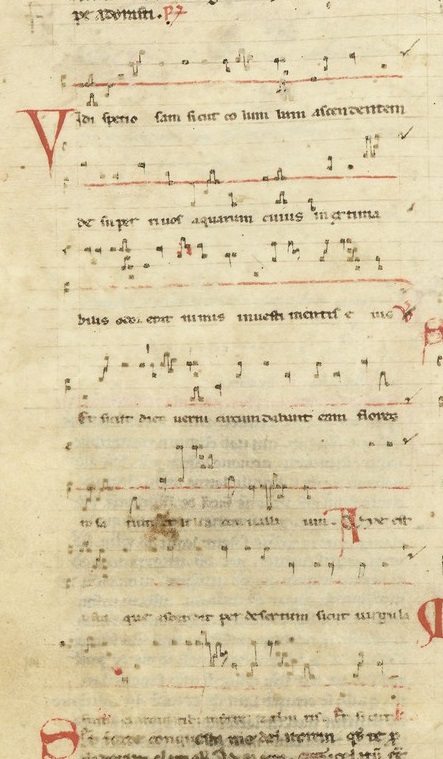

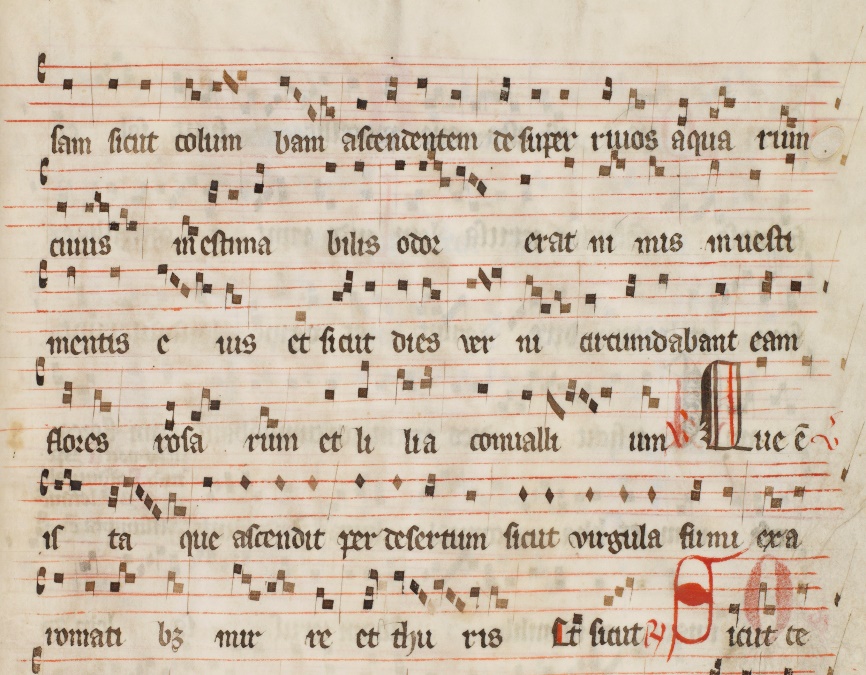
Franciscan antiphoner, fol. 42v-43r detail (right): Assumption, first responsory Vidi speciosam, and verse Quae est ista. (MS.1996.097, John J. Burns Library, Boston College).
As designated copyists and disseminators of chant, then, Franciscans do appear to have been highly reliable stewards; as Andrew Mitchell observed in his study of early Franciscan office chants: “The Franciscan manuscripts are characterized by a high degree of uniformity” (Mitchell 2003, 256). Moreover, in propagating the papally authorized exemplar of restored “Gregorian” chant (cantu antiqua) internationally from the mid-1200s onwards, the Franciscans were effectively laying the ground work for the papacy’s own more systematic musical attempt, 300 years later, to try to re-impose curial chant on the “universal” church. Thus, early Franciscan office manuscripts also have an unintended historical significance today, as precursors of such enormously influential early printed exemplars of the music of the Roman office as Lucantonio Guinta’s Antiphonarium Romanum 1503 (by no means coincidentally, also edited by Franciscus de Brugis, an observant Franciscan), its post-Tridentine succesors, and, ultimately, of the modern Vatican and Solesmes editions.
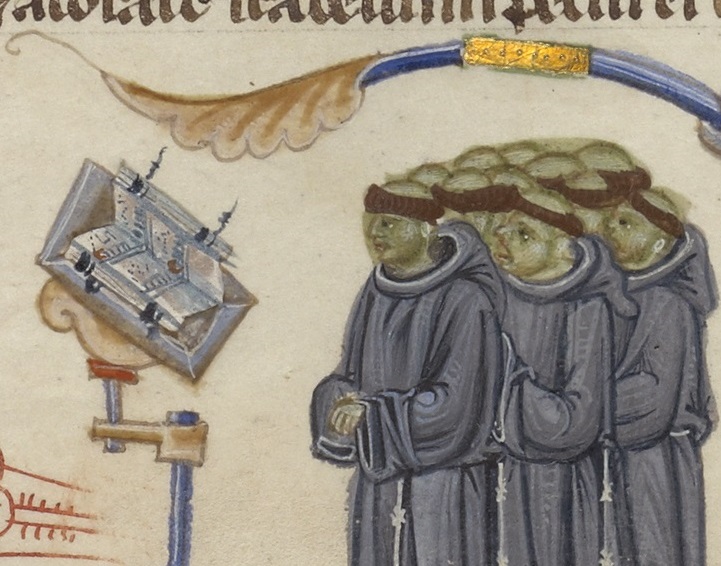
The earliest (1200s) Franciscan books of office chants are Italian and copied in so-called central Italian “transitional” notation (see especially I-Ac 693 and I-Ac-694). Nevertheless, as early as c.1251, the Franciscan general chapter held in Genoa, Italy, decreed that, contrary to the still usual central Italian practice, the order’s own chant books were to be written in French square notes of black ink, on staves of four red lines. These regulations were themselves sometimes copied into the books (CH-Solo S.III.1, fol. 1r; Molitor 1901, 299-300: Van Dijk 1963, 360-61; Huglo 2004):
In primis iniungitur fratribus de cetero, tam in gradualibus quam antiphonaries
nocturnis et aliis, faciant notam quadratam et quatuor lineas, omnes rubeas
sive nigras. Et littera aperte et distincte scribatur, ita quod nota congrue super
suam litteram valeat ordinate. Et fiant line modo debito distantes, ne note hinc
inde comprimatur ab eis. Secundo quod custodiant eandem litteram, eandem
notam cum suis ligaturis, easdem pausas, que in exemplaribus correctis cum
magna diligentia continentur, nichil scienter addito vel remoto . . .
A similar set of regulations promulgated by the Dominican order mandated copying a custos (direct) at the end of each staff (Au-Mslv, Poissy antiphonal, fol. 4r):
Puncta etiam directiva posita in fine linarum ad innuendum ubi prima nota
sequentis linee debeat in chori diligenter a notatoribus observentur.
The late Michel Huglo suggested that absence of any mention of the custos in the Franciscan regulations might reflect the fact that they were issued in Genoa, the custos being so commonly used in central Italy that there was no need to stipulate its use (Huglo 1992). Among early Franciscan office books that otherwise follow the Genoa rules to the letter, CH-Fco 2 does also have directs, added systematically, though possibly later by a hand different from that of the main music scribe. Whereas, as we have observed above, of the two principal Burns music scribes, music hand 3 does use directs, while music hand 1 does not.
But whether in the older Italian or newer French notation, the most distinctive feature of Burns and the other early Franciscan manuscripts in the CANTUS database is the curial-Franciscan cursus of feasts and chants itself. Also arguably reflecting the name and intent of the ultimate text exemplar, the breviary, the curial-Franciscan cursus of sanctorale proper offices is markedly curtailed, by comparison with those of many other cathedral and monastic uses of the 1200s and 1300s (see for instance GB-WO F.160). Excepting those for Francis and Clare, the absence in Burns of proper offices for any other recent and local saints such as proliferate in many other antiphoners is notable; in fact, all the other saints accorded a proper office in Burns are pre-fifth century (the latest, Martin, having died in 397). Moreover, since this “primitive” calendar necessarily reflects curial Roman usage, the claim in the only earlier published description of Burns, that “judged . . . by the proper of saints in the calendar, the manuscript was produced in South Germany” (O’Neill et al. 2000) simply cannot be sustained. Also notably absent from Burns and other early Franciscan books, for the same reason, are some other celebrations already widely observed outside Rome, but not adopted by the curia until later, such as the offices of the Transfiguration (6 August) (compare CANTUS Transfiguratio Dom.), and the Conception of Mary (8 December) (CANTUS Conceptio Mariae). While two of the very earliest Franciscan antiphoners, I-Ac 693 and I-Ac 694, lack even a proper office for Francis himself.
The Burns antiphoner’s curial-Franciscan credentials, then, do not rest on its inclusion of offices for Francis and Clare alone; which is fortunate, since the same proper offices for both saints also appear in non-Franciscan books during the 1300s (see, for instance, the office of Francis in the Benedictine CH-SGs 388). On the other hand, it is unlikely that these two alone would be chosen to represent recent saints in an antiphoner compiled by anyone other than the Franciscans. Yet Burns would be identifiable as belonging to the curial-Franciscan tradition even without them. This turns out to be more important than it might at first seem, given the lack of other internal evidence, or provenance data, that identify the book unequivocally with the Franciscan order. The absence of any definitively Franciscan rubrics, and of offices or other reference to other Franciscan saints or commemorations, remains an interesting problem, discussed more fully below. And even the rubrics that it does include for Francis and Clare are surprisingly laconic. Francis’s office is introduced simply: “In vigilia s[anc]ti francisci . . .” (fol. 59r); and Clare’s, “De sancta clara” (fol. 84r). Indeed, the only apparent concession to Franciscan piety in the whole book, and then among the slightly later additions to parts 1 and 2 of the main manuscript, is the heading for the Francis sequence, Caeli cives in colono (fol. 114r), which at least refers to the founder, as the Order preferred, as “De Beato Francisco” – Blessed Francis.
The Corpus Christi office
One of the first new proper offices to find its way into early Franciscan antiphoners was that of Corpus Christi, Sacerdos in aeternum, promulgated in 1264 by Urban IV (Jacques Pantaléon), though perhaps not widely observed even by many Franciscans until confirmation by Clement V (Raymond Bertrand de Got) at the Council of Vienne in 1311-12. As might be expected, the earliest Franciscan antiphoners, D-Ma 12o Cmm 1, I-Nn vi.E 20, and I-Rvat lat. 8737, lack the Corpus Christi office completely (though the Vatican manuscript has several lacunas). However, in others, it does appear, though evidently added well after the main body of the book was completed. But by 1300, it was also becoming common to find it copied into new liturgical manuscripts in calendrical sequence, almost always in its eventually fixed position within the temporale.
That it was generally to be kept as a late Spring or early Summer feast was agreed quite early. In 1246, one the feast’s first sponsors, Robert de Turotte, bishop of Liège, had established that it was to be observed in his diocese on the Thursday after the octave of Trinity (“feria quinta proxima post octava Trinitatis”) (Rubin 174). And although Urban IV set it “universally” for the Thursday after Pentecost, the feast was ultimately placed in the compromise position of the Thursday after Trinity Sunday, moving annually within the outside dates of 21 May and 24 June.
This does not quite prepare us for the Burns antiphoner, however. There too, the office appears to have been added, but during the copying of part 1B of the manuscript. Plausibly the scribe already had this perfectly serviceable copy of the Corpus office to hand, and rather than copy it again, simply inserted it before the remainder of the proper of the saints. Even so, the placement of a feast usually celebrated in May or June, between the August feasts of the Assumption (15 August), and the Beheading of John the Baptist (29 August) is unexpected. Such double displacement is not entirely unknown elsewhere, however. A contemporary non-Franciscan antiphoner in CANTUS that likewise includes Corpus Christi among its sanctorale cycle is A-KN 589, and there too the office inhabits not its expected May-June slot, but is copied between the Dispersion of the Apostles (15 July) and Margaret of Antioch (20 July).
The office itself is musically remarkable for being tonally ordered, after the manner of Julian of Speyer’s earlier Francis office (see below), though unlike it the texts are unrhyming and were fitted to slightly adapted versions of preexistent chant melodies, rather than Julian’s newly composed ones. Thomas Aquinas is traditionally attributed with authorship of the new words, though that now seems unlikely. The original contrafactum scheme was usefully outlined in marginal annotations to the manuscript Paris, Bibliothèque nationale, BNF 1143 (transcribed by Walters et al. 2006, 83-85). It indicates, for instance, that the words of the opening antiphon Sacerdos in aeternum were fitted contra “gloria tibi trinitas de trinitate”.
The rhymed office of Francis by Julian of Speyer (c.1232)
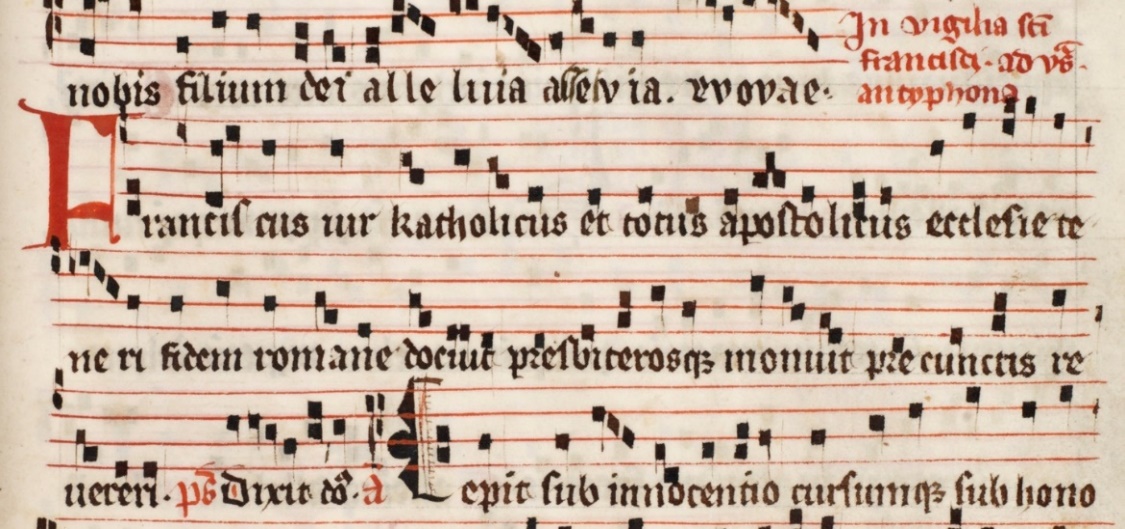
Apart from its curial-Franciscan cursus, Burns has only three distinctive Franciscan contents, namely in the main part of the manuscript (part 1B) the rhymed offices of Francis and Clare, standard within the order during the 1300s, and among the later additions the Francis sequence Caeli cives in colono. This leaves the earlier portion of the proper (part 1A) without a single Franciscan feast, the most surprising omission for a manuscript of this date being the office of Anthony of Padua (13 June).
Francis was canonized in 1228, and by 4 October 1235, the words and music of a full rhymed office for the saint had been written and composed by a Paris-based member of the Franciscan order, Julian of Speyer (d. c.1250). It is Julian’s office, Franciscus vir catholicus, that is included complete in Burns and in seven other Franciscan (and several non-Franciscan) books indexed in CANTUS (see Francisci).
Julian’s office was almost certainly complete by the mid 1230s, though there is neither a copy nor other definitive description of it until much later. Two of the earliest copies, those in D-Ma 12o Cmm 1 and I-Rvat lat. 8737, both in Italian transitional notation, were the basis of the first modern critical edition of both the words and music (Felder 1901, which also includes facsimiles of the whole office from the first of these exemplars). Though Julian newly composed the words and melodies of most of the office, he incorporated into his compositional plan several pre-existing chants written by Gregory IX, cardinal Tommaso da Capua (d. 1239), and cardinal Rainerio Capoci (d. 1250) of Viterbo. Moreover, the authors of two of these chants were named by the Burns copyist in the manuscipt itself. Before the cue for the vespers hymn Proles de caelo prodiit, a rubric ascribes it to Gregory IX (“h[ymnus] d[omini] g[re]gorii p[a]p[ae] . . .”), and likewise to Tomasso da Capua the hymn In caelesti collegio and responsory Carnis spicam. However, the other traditional ascription of De paupertatis horreo to Gregory went unnoted by the Burns scribe.

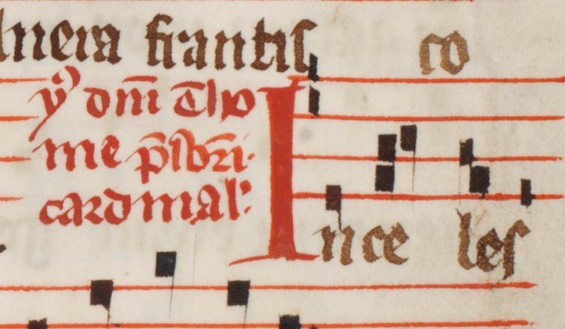

The rhymed office of Francis in Burns, texts by Julian of Speyer, unless otherwise indicated
| Mode | ||||
| Vespers | Antiphon 1 | Franciscus vir catholicus (59r) | 1 | |
| Vespers | Antiphon 2 | Coepit sub innocentio (59r) | 2 | |
| Vespers | Antiphon 3 | Hunc sanctus praeelegerat (59r) | 3 | |
| Vespers | Antiphon 4 | Franciscus evangelicum (59r) | 4 | |
| Vespers | Antiphon 5 | Hic creaturis imperat (59v) | 5 | |
| Vespers | Hymn | Proles de caelo (cue only) (59v) | * | Gregory IX |
| Vespers | Antiphon Magnificat | O stupor et gaudium (59v) | 6 | |
| Matins | Invitatory | Regi qui fecit opera Christo (60r) | 2 | |
| Matins | Hymn | In caelestis collegio (cue only) (60r) | * | Tommaso da Capua |
| Matins | Antiphon 1 | Hic vir in vanitatibus (60r) | 1 | |
| Matins | Antiphon 2 | Excelsi dexterae gratia (60r) | 2 | |
| Matins | Antiphon 3 | Mansuescit sed non penitus (60r) | 3 | |
| Matins | Responsory 1 | Franciscus ut in publicum (60v) | 1 | |
| Matins | Responsory 2 | In dei fervens opere statim (60v) | 2 | |
| Matins | Responsory 3 | Dum pater hunc persequitur (61r) | 3 | |
| Matins | Antiphon 4 | Pertractum domi verberat (61r) | 4 | |
| Matins | Antiphon 5 | Jam libet patris furiae (61v) | 5 | |
| Matins | Antiphon 6 | Ductus ad loci praesulem (61v) | 6 | |
| Matins | Responsory 4 | Dum seminudo corpore (61v) | 4 | |
| Matins | Responsory 5 | Amicum quaerit pristinum (61v) | 5 | |
| Matins | Responsory 6 | Audit in evangelio (62r) | 6 | |
| Matins | Antiphon 7 | Cor verbis novae gratiae (62v) | 7 | |
| Matins | Antiphon 8 | Pacem salutem nuntiat (62v) | 8 | |
| Matins | Antiphon 9 | Ut novis sancti merita (62v) | 1 | |
| Matins | Responsory 7 | Carnis spicam contemptus (62v) | 7 | Tommaso da Capua |
| Matins | Responsory 8 | De paupertatis horreo (63r) | 8 | Gregory IX |
| Matins | Responsory 9 | Sex fratrum pater septimus (63v) | 1 | |
| Extra responsories, additional to Julian’s office (63v-64r) | ||||
| Lauds | Antiphon 1 | Sanctus Franciscus praeviis (64v) | 2 | |
| Lauds | Antiphon 2 | Hic praedicando circuit (65r) | 3 | |
| Lauds | Antiphon 3 | Tres ordines hic ordinat (65r) | 4 | |
| Lauds | Antiphon 4 | Doctus doctrice gratia (65r) | 5 | |
| Lauds | Antiphon 5 | Laudans laudare monuit (65r) | 6 | |
| Lauds | Hymn | Plaude turba paupercula (cue only) (65v) | * | Rainerio Capoci |
| Lauds | Antiphon Benedictus | O martyr desiderio (65v) | 7 | |
| Vespers 2 | Antiphon Magnificat | O virum mirabilem (66r) | 8 |
Nevertheless, there is no doubt that the office overall is the product of Julian’s systemtatic authorial (textual) and compositional (musical) endeavor, only the incorporated hymns falling outside his musical and poetic plan. Textually, the core items—whether newly written by Julian, or those written by others and incorporated by him—are all formatted as metrical rhyming stanzas, as so too are all those “extra” chants also listed above. Julian’s quite straightforward verse scheme alters to reflect the liturgical weight borne by each various genre of chants from office to office. Of those parts attributed to Julian himself, the five psalm antiphons of first vespers and the five of lauds (repeated at second vespers), are all written in six-line single stanzas (lines of 887887 syllables) with an AABCCB rhyming scheme, audibly recalling one of the most distinctive strategies of Victorine sequences, as in the opening vespers antiphon:
Franciscus, vir catholicus
Et totus apostolicus,
Ecclesiae teneri
Fidem romanae docuit,
Presbyterosque monuit
Prae cunctis revereri.
Julian’s more numerous psalm antiphons for matins, nine in all, consist of single four-line stanzas (8787, ABAB, quite distinct from the standard meter of incorporated four-line hymns)—and so too the invitatory—as shown here in his first matins antiphon:
Hic vir in vanitatibus
Nutritus indecenter,
Plus quis nutritoribus
Se gessit insolenter.
Reflecting their focal importance, the three gospel-canticle antiphons are structured as much longer stanzas, and with necessarily more complex rhyming schemes; there is a subtle reverse progression from that for the Magnificat at second vespers, the O virum mirabilem with 14 lines, to O martyr desiderio for the Benedictus at lauds with 15 lines, and O stupor et gaudium for the Magnificat at first vespers with 16 lines, crowning Julian’s scheme.
One original feature of Julian’s Francis office did not survive in the Burns copy. Writing less than a decade after the founder’s death, Julian could still devote the whole of his first antiphon for matins to meditating on the founder’s poor behavior before his conversion (“he behaved worse than his elders”):
Hic vir de [in] vanitatibus,
nutritus indecenter
plus suis nutritoribus
se gessit insolenter.
This is how his text was transmitted in two of the earliest Franciscan sources, D-Ma 12o Cmm 1 and I-Rvat lat. 8737 (Felder 1901; though CANTUS wrongly registers the later version). A further quarter of a century on, however, the chapter of Narbonne took a different view, and ordered that Julian’s last two lines be altered to fast-track Francis to conversion (“he was saved by divine grace”):
In illa antiphona beati Francisci que sic incipit Hic vir de vanitatibus nutritus
indecenter fiat talis mutatio Divinis carismatibus preventus est clementer.
(Van Dijk, Sources, I, 419-20; Guilloux, Les decisions.) Thus, any Franciscan sources of otherwise unknown date that transmit the later version—as do Burns and CH-Fco 2 (see fol. 212v)—can at least be confidently dated to after 1260.
The Clare contrafactum, Iam sancta Clare claritas

Whereas Francis’s office was copied into Burns in calendar sequence among the rest of the proper of the saints, Clare’s office was added at the end, as if an afterthought, perhaps suggesting that it was new or recent at the time the book was copied. Since, however, it is in the same hands as the foregoing offices (text hand 2 and music hand 3), it may be that its position merely reflects that in the exemplar used by the Burns scribes.
We do not know who wrote the words of the office Clare, or precisely when (for modern edition, see AH 5, no. 54, 157-60). But we do know that almost all of the music for it was borrowed from Julian of Speyer’s office of Francis, and that the Clare office also preserves Julian’s numerical modal ordering. This was particularly apt symbolically, because just as Clare was Francis’s sister, so their offices are audibly related. As can be seen in the examples below, the new texts for Clare were written to the same metrical rhyme schemes as Julian’s texts for Francis. Because of this, the Clare texts also fit exactly with the melodies for Julian’s Francis office.
| Francis | Clare | |
| Vespers antiphon 1 | Franciscus, vir catholicus Et totus apostolicus, Ecclesiae teneri Fidem romanae docuit, Presbyterosque monuit Prae cunctis revereri. |
Jam sanctae Clarae claritas |
| Matins antiphon 1 | Hic vir in vanitatibus | Haec una de prudentibus |
| Matins responsory 1 | Franciscus ut in publicum Cessat negotiari, In agrum mox dominicum Secedit meditari; Inventum evangelicum Thesaurum vult mercari. Verse: Deum, quid agat, unicum Consultans, audit caelicum Insigne sibi dari. Inventum evangelicum Thesaurum vult mercari. |
Francisci prima plantula Castitatis per saecula |
The principal chants in the offices of Francis and Clare compared
| Francis | Mode | Clare | Mode | ||
| Vespers | Antiphon 1 | Franciscus vir catholicus (59r) | 1 | Jam sanctae Clarae claritas (84r) | 1 |
| Vespers | Antiphon 2 | Coepit sub innocentio (59r) | 2 | Mundi totius gloriam (84r) | 2 |
| Vespers | Antiphon 3 | Hunc sanctus praeelegerat (59r) | 3 | Haec in paternis laudibus (84v) | 3 |
| Vespers | Antiphon 4 | Franciscus evangelicum(59r) | 4 | Sacra spirat infantia (84v) | 4 |
| Vespers | Antiphon 5 | Hic creaturis imperat (59v) | 5 | Hanc et papa Gregorius (84v) | 5 |
| Vespers | Antiphon Magnificat | O stupor et gaudium (59v) | 6 | O decus et gaudium (85r) | 6 |
| Matins | Antiphon 1 | Hic vir in vanitatibus (60r) | 1 | Haec una de prudentibus (85r) | 1 |
| Matins | Antiphon 2 | Excelsi dexterae gratia (60r) | 2 | Excelsi servus virginem (85v) | 2 |
| Matins | Antiphon 3 | Mansuescit sed non penitus (60r) | 3 | Cuncta pro Christi nomine (85r) | 3 |
| Matins | Responsory 1 | Franciscus ut in publicum (60v) | 1 | Francisci pia plantula (85r) | 1 |
| Matins | Responsory 2 | In dei fervens opere statim (60v) | 2 | In via paenitentiae (86r) | 2 |
| Matins | Responsory 3 | Dum pater hunc persequitur (61r) | 3 | Hic paupertatis titulo (86r) | 3 |
| Matins | Antiphon 4 | Pertractum domi verberat ((61r) | 4 | Oblata per Gregorium (86r) | 4 |
| Matins | Antiphon 5 | Jam libet patris furiae (61v) | 5 | Parat magistra vasculum (86v) | 5 |
| Matins | Antiphon 6 | Ductus ad loci praesulem (61v) | 6 | Hortatur haec ut pauperes (86v) | 6 |
| Matins | Responsory 4 | Dum seminudo corpore (61v) | 4 | A civibus obsidio (86v) | 4 |
| Matins | Responsory 5 | Amicum quaerit pristinum (61v) | 5 | Amica crucis plangere (86v) | 5 |
| Matins | Responsory 6 | Audit in evangelio (62r) | 6 | Vivens in mundo labili (87r) | 6 |
| Matins | Antiphon 7 | Cor verbis novae gratiae (62v) | 7 | Cor verbis sapientiae (87r) | 7 |
| Matins | Antiphon 8 | Pacem salutem nuntiat (62v) | 8 | Trahit de testa nucleum (87v) | 8 |
| Matins | Antiphon 9 | Ut novis sancti merita (62v) | 1 | Format Clara discipulas (87v) | 1 |
| Matins | Responsory 7 | Carnis spicam contemptus are (62v) | 7 | Carnis templo soluto (87v) | 7 |
| Matins | Responsory 8 | De paupertatis horreo (63r) | 8 | De pane pascit unico (88r) | 8 |
| Matins | Responsory 9 | Sex fratrum pater septimus (63v) | 1 | - | - |
| Lauds | Antiphon 1 | Sanctus Franciscus praeviis (64v) | 2 | Post vitae Clarae terminum (88r) | 2 |
| Lauds | Antiphon 2 | Hic praedicando circuit (65r) | 3 | Agnes ad agni nuptias (88r) | 3 |
| Lauds | Antiphon 3 | Tres ordines hic ordinat (65r) | 4 | Sicut sorore praevia (88v) | 4 |
| Lauds | Antiphon 4 | Doctus doctrice gratia (65r) | 5 | Honorat Christi dextera (88v) | 5 |
| Lauds | Antiphon 5 | Laudans laudare monuit (65r) | 6 | Laudans laudare studeat (88v) | 6 |
| Lauds | Antiphon Benedictus | O martyr desiderio (65v) | 7 | Novum sidus emicuit (89r) | 1 |
| Vespers 2 | Antiphon Magnificat | O virum mirabilem (66r) | 8 | Duce caelesti numine (89r) | 6 |
Only the final two chants in the Clare office do not derive from Julian’s poetic and musical plan, the gospel canticle antiphons Duce caelesti numine and Novum sidus emicuit. They are almost certainly the two earliest proper chants for Clare. Their texts and melodies probably date to as early as the time of her canonization in 1255 by Alexander IV (Rinaldo di Jenne), and indeed, according to van Dijk, the words are “probably” by Alexander himself (Van Dijk 1966, 161).
The antiphon O decus et gaudium

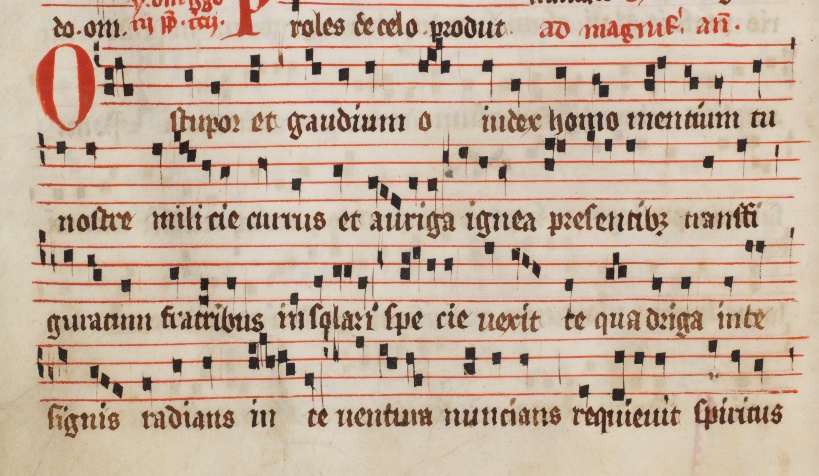
The most distinctive feature of the Burns copy of the Clare office is the Magnificat antiphon at first vespers, O decus et gaudium, in modal order, and to the mode 6 melody of its model, arguably the crowning glory of Julian’s Francis office, the 16-line antiphon O stupor et gaudium. Curiously, however, none of the bare handful of other Clare offices indexed in CANTUS has this chant, in each case assigning one or other of the pre-Julian antiphons Duce caelesti or Novum sidus to this important slot instead.
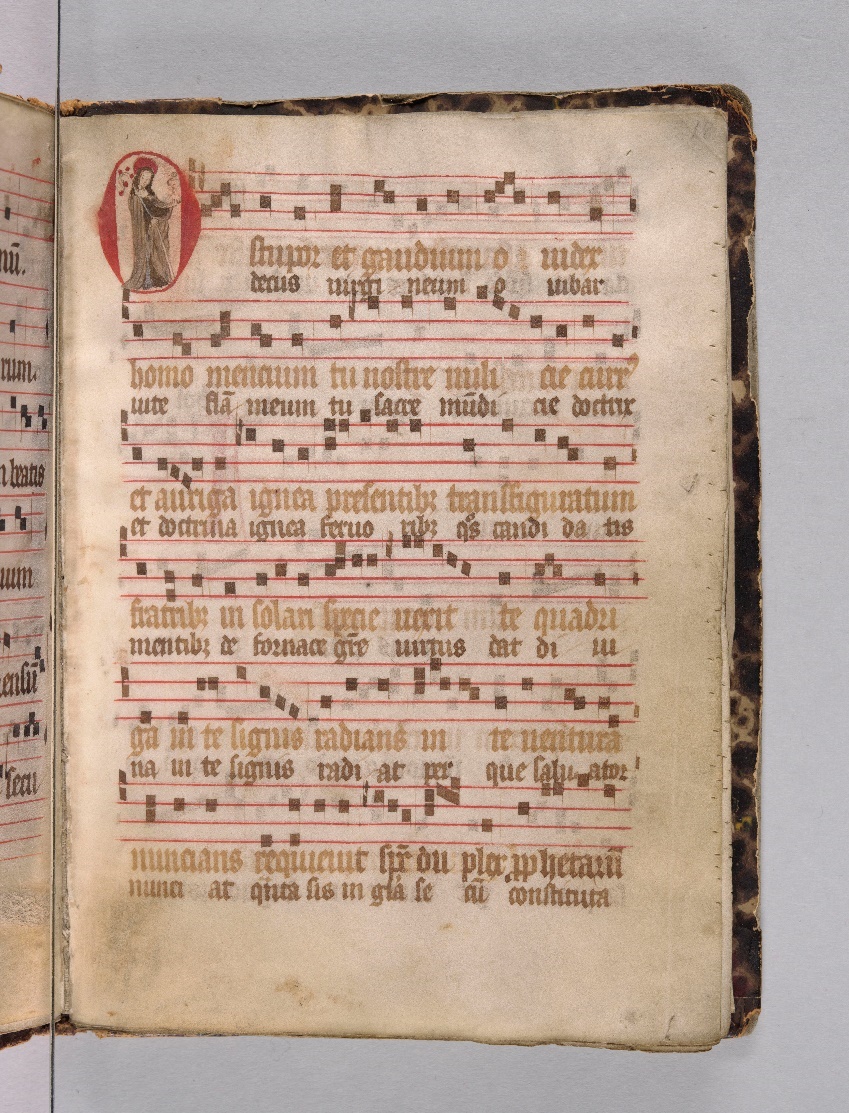
Another intriguing partial source of the Clare office is the Franciscan manuscript, US-NYcub Plimpton 34 which is not an antiphoner, but a processional. It presents four paired items from each of the Francis and Clare offices with music and texts uniquely underlaid in parallel. Of chief interest here, however, is the Plimpton text, O decus virgineum, pictured above, which, as the source graphically demonstrates, is another Clare contrafactum of Julian’s O stupor et gaudium. Notice also the image of Clare herself in the initial.
O stupor et gaudium / O decus et gaudium

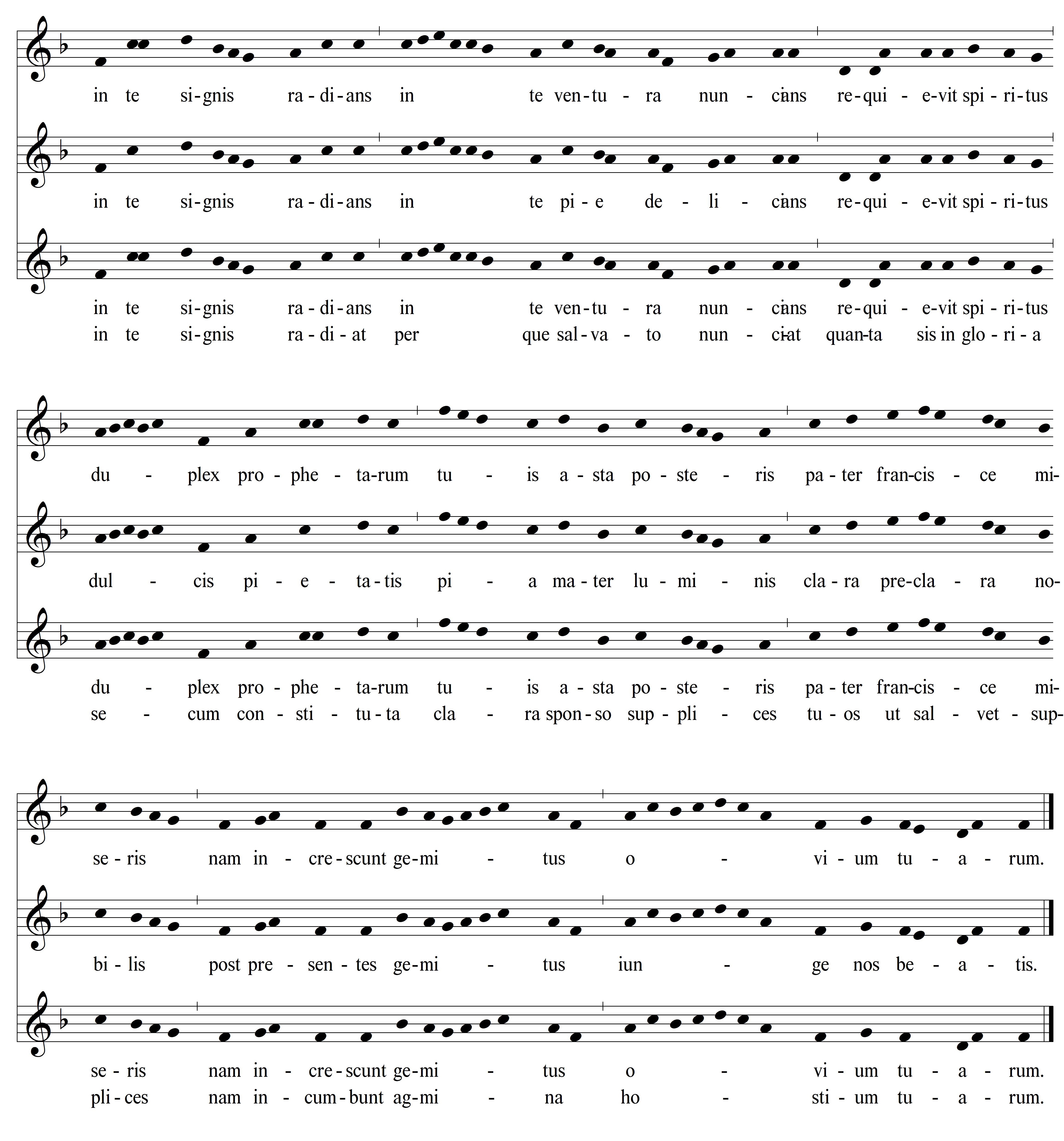
Polyphony in Caeli solem imitantes

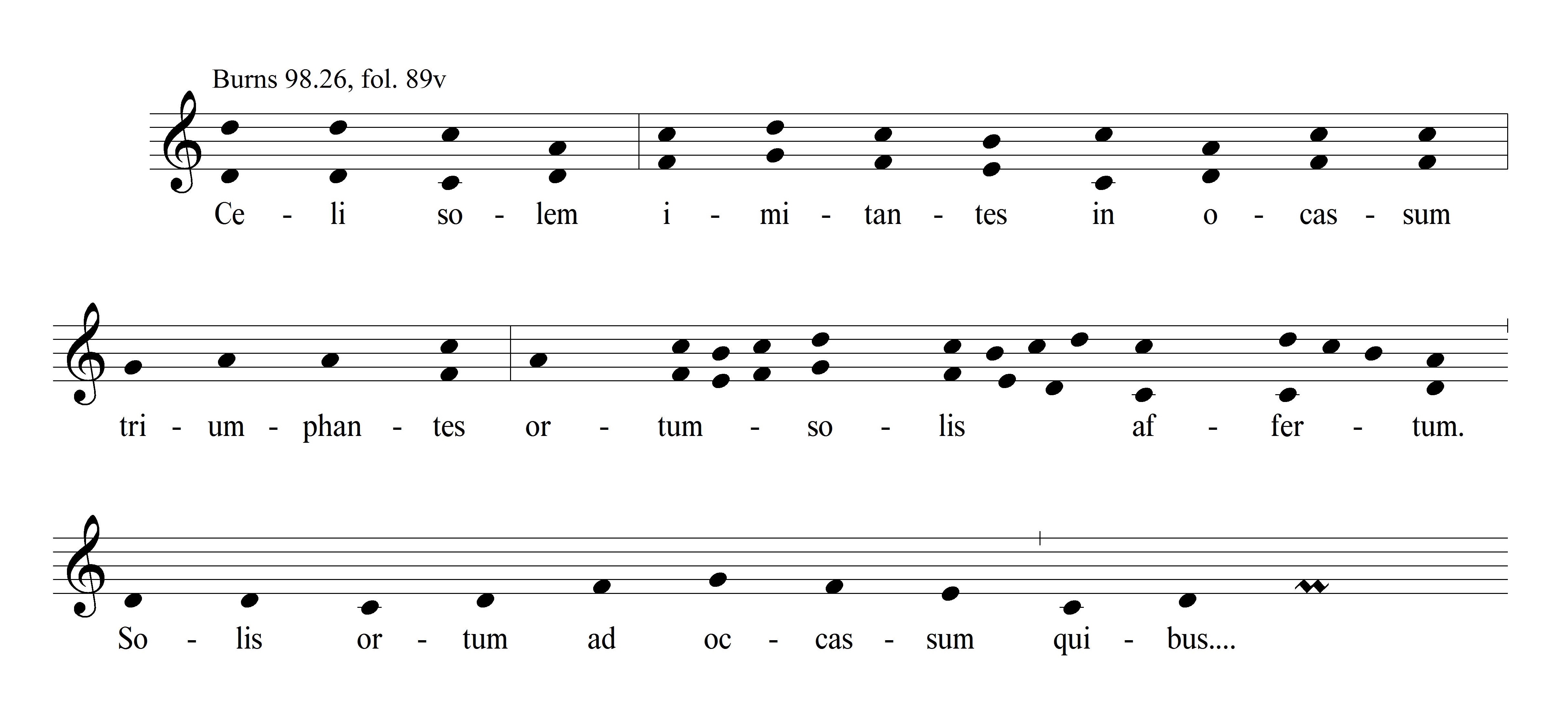
Given the dating of this manuscript to the 1300s, this lone example of polyphony is surprisingly archaic in style, a simple 2-voice discant, the composer clearly preferring parallel movement in fifths and octaves, and those within the very limited range whereby the upper voice rises no higher than the D above middle C. This limitation accounts for the peculiarity of the unisons on “triumphan-tes”. The fact that chant voice in later verses ranges more often above A probably also partly explains why polyphony is limited to the opening half verse.
The resulting polyphony is considerably more primitive than other types of discant, such as that described in the English Franciscan Quattuor principalia (Bodleian Digby 90) and even more primitive than the many of the very simplest of other surviving examples, which typically allow the use of fourths, thirds, sixths, and sevenths. Furthermore, there is little obvious point of comparison between the Caeli solem polyphonic verse in Burns and the handful of more sophisticated prosas/sequences with polyphony in the roughly contemporary Franciscan source, I-Ac 695, whose two voices move predominantly in contrary motion and through a full range of intervals (Shinnick 1997, 489-530).